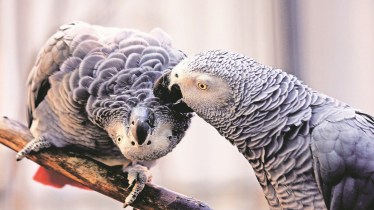Faith, belief or lending a helping hand are not just attributes confined to human beings but in the insects and animal kingdom too. There are several animals who pair and bond with only one mate, and spend a life together with their partner.
An article published in The New York Times recently talked about Sunny and Ned, shingleback lizards that live at Melbourne Museum in Australia and return to the same partner during mating season year after year. It also stated that one lizard couple in a long-term study had been pairing for 27 years and were still going strong when the study ended. Thus, reptiles are considered the most famous long-term couplers.
Apart from lizards, albatrosses, prairie voles and owl monkeys, turtle doves and swans are also more socially bonded and socially monogamous in a relationship. A turtle dove is already a symbol of innocence, purity and enduring love and swans famously mate for life. Snowy owls nest on the Arctic tundra and depend on food, and in particularly lean times a usually monogamous pair of owls may not breed at all.
Also read: Joshimath sinking! Land descended 5.4 cm in just 12 days: ISRO report
Male prairie voles bond with female ones. The animal is very much close to humans as their brains release chemicals just like humans or even sinks into depression just like a human. Owl monkeys are tropical tree-dwellers known for being the only nocturnal monkey. A report published in the National Library of Medicine, says monogamous owl monkeys in the Argentinean Chaco have a default social system and occupy home ranges.
California mice are very social and take up the bulk of the parenting responsibilities. Besides bald eagles, albatrosses perform an elaborate dance ritual to bond with each other. But an interesting fact here is that not all animals are monogamous. For example, tigers are polygamous; a male tiger might have several partners and so can a tigress.
“Monogamy can be seen in jackals or a barking deer, also known as the Indian muntjac. But most animals are polygamous as it makes the gene pool stronger, helps different animals survive the odds of nature,” says filmmaker and conservationist Suyash Keshari.
In fact, lending a helping hand is another common dimension where animals and insects score high. In a report published in the journal Current Biology, African grey parrots, but not blue-headed macaws, voluntarily and spontaneously help partners obtain food rewards and prosocial behaviours were reciprocated irrespective of the partner’s need. Blue-headed macaws, in contrast, transferred hardly any tokens.
How this unique scientific framework works in humans is more easily understood, but animals also are driven to act altruistically, if not always. In fact, species like bees, ants and termites are known to be great and best examples of biological altruism, or we can also say that some acts make these animals the best social creatures.
A report by the Royal Society publishing suggests a finding where common vampire bats insist on food sharing for their mates, which means these have been consistent with social bonding and their food-sharing network was consistent and correlated with mutual allogrooming, a form of caregiving through physical contact.
In 2013, Moko the dolphin, a regular visitor to the coast of Mahia on the east coast of New Zealand‘s North Island, became an instant hero after leading two pygmy whales that had repeatedly strayed into deep water.
